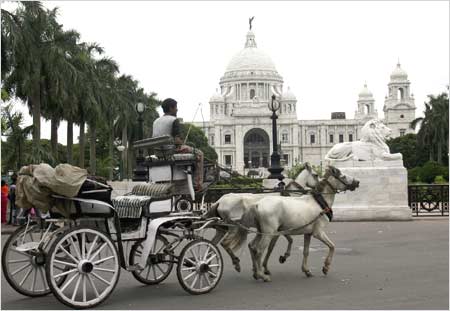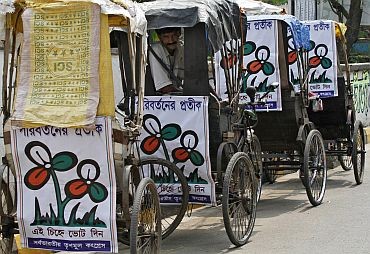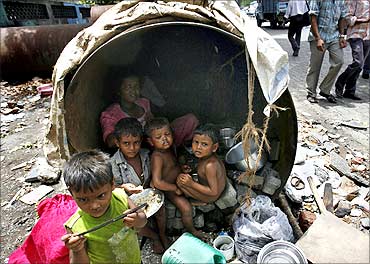I’m not a victim, I say. And realize to my surprise, that indeed,
it is a thing of the past for me. The majority of the female gender in
India is, or has been victim at some point in their lives. The abuse
they suffer can be in many forms, economic, verbal, physical, sexual, and
emotional. It is not only the illiterate that are affected; education and
employment doesn’t always protect the others. Culturally, they rarely get help;
rather their integrity is questioned. The trauma of an abusive
experience hounds them, and perhaps gets carried into their social
interactions.
Several decades ago, a Western woman journalist, curious about
life as a non-white in London, decided to change her appearance and go
undercover as an Asian. With wig, contact lenses, appropriate makeup and
attire, she transformed from one race to another. The few weeks of subtle
social discrimination experienced were a revelation, and eventually, she
too felt hunted. While commuting on a train in the disguise, she heard two
other white women patronizing her. They obviously assumed that
being Asian, she wouldn’t have the language. It was not her appearance
that irritated, they said, but her attitude.
The downtrodden expect abuse. That they are beaten
into the dust and cannot hope to get up again, is projected in look and
body language. Perhaps their unarticulated fears attract further aggression.
Verbal or physical abuse is common sight on the city streets. Hardly anybody
protests. Many may even condone it, and
outside interventions often make things harder for the victim. Like kicking
pets in petulance, men in India tend to take their frustrations on those that can’t
or don’t fight back. But mostly, society is immune to the abuse of
women.
Another day, three little girls were on their way to
school, along with a young man, most probably a member of their extended
family, or a neighbour. The littlest girl had been unable to cross the road
with the others, and remained stranded on the far curb. The fellow didn’t even
notice that she had been left behind. Several bystanders at the crossing called
out to attract his attention: Hey, hey, take this one with you! Then the
man marched angrily back to the child and slapped her hard on the head. In
shock and pain, she burst into tears. Slap yourself first, I shouted,
walking up to point an accusing finger, the fault is yours entirely. He
went quiet, embarrassed into behaving by the public scrutiny.
In days gone by, the joint family structure had several
generation and extended families living under the same roof. The cloistering of
women was extreme. During my mother’s girlhood in the 1930s and 1940s, young
women couldn’t stand at the windows in case they caught the eye of some man
before marriage, and they were forbidden from meeting any man alone. It
seems to me that there was a positive to it too, in terms of their safety from
predators.
Post-independence, nuclear family units became the norm
mostly for economic reasons. It was instrumental in opening doors to women’s
education and employment. However, it did not remove the feudal attitude to
gender; it just made the access to women easier. In the new family structure,
family ties remained the same. Mothers continued to view men as they were
brought up to, as the superior beings to look up to. They trusted the male
‘family members’ in its extended branches implicitly.
It never occurred to them that by putting their little
girls in their control they were putting them in harm’s way. The ignorance of
the mothers allowed the uncomprehending children as young as four to
be abused and molested at will. I know this, because it happened to me too. The
home itself can be an unsafe environment for many women and girls. They are
socialized early into the trauma of gender.
The more she did that, the more his ego inflated. Every now and then he stopped, and turned on her aggressively. Wagging his finger in her face, he hissed threats and insults. I heard him say she was so ugly she sickened him, that she was a burden around his neck, and that he couldn’t wait to be rid of her. She should have rapped him across the mug and stalked off. But instead, she just put her hands up piteously, as if to ward off his words.
It made my blood boil, and I stopped nearby and glared at
the man. Other passersby definitely heard him too, but because the woman had a vermillion
streak in her hair (signifying the marital state), nobody intervened. The
social environment holds out no support whatsoever for the victims of marital
abuse. It is traditional, instead, to consider a wife the husband’s property;
with which argument, marital abusers count on escaping censure.
I know, because I was in such a relationship,
where this argument was repeatedly used. I was educated, but perhaps I too
projected the characteristically abysmal self-esteem of victims. It didn’t
matter that I changed attitude like a chameleon changes colour, to keep the
peace and protect children and pets. Punishment for some slight, real or
imagined, was imminent, and would be vicious. At a time when the marital and
custody laws favoured the male, it was a hostage situation.
After several years, I recently met my own brother. He
is a non-resident Indian, and has been a citizen of the lands of plenty for
several decades. We are closest in age, and in our younger days, were
constantly at loggerheads. The special treatment he always seemed to get,
especially from my mother, irked me no end. We have mellowed in later years,
but still, I admit, that although we do not come to blows any more, we
occasionally lapse into childish behaviours, reminiscent of our younger days.
The matter of our argument, the other day, was actually
trivial. But I realized
that his Indianness is entrenched in a time gone by. Despite living in a developed society for several decades, the conditioned
cultural responses reactivate on the shores of the mother country. In an instant, the
general mistrust of gender of those past times came alive in him. He was
like an alpha male that had to dominate the group and the women! In his mind, possibly, he was being the elder,
the male head of family, and quite unaware that that behaviour pattern
could now be termed abusive.
The revisit of the past brought me enlightenment.
Although we were brought up in the same environment in the past, I have moved
on, have emancipated from victim-hood. I no longer placate or change attitude.
I am assertive, and relate on equal terms. Masculine intimidations are of no
consequence to me today. They seem comically archaic, and I am free of their
toxicity. I’m not a victim, I
say. Not anymore. I have been in the pits, and now I stand up.



































